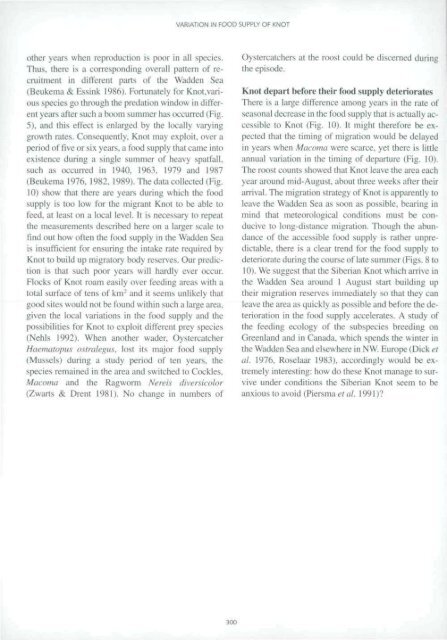waders and their estuarine food supplies - Vlaams Instituut voor de ...
waders and their estuarine food supplies - Vlaams Instituut voor de ...
waders and their estuarine food supplies - Vlaams Instituut voor de ...
Create successful ePaper yourself
Turn your PDF publications into a flip-book with our unique Google optimized e-Paper software.
oilier years when reproduction is poor in all species.<br />
Thus, there is a corresponding overall pattern of recruitment<br />
in different parts of the Wad<strong>de</strong>n Sea<br />
I Beukema cv Fssink 1986). Fortunate!) for Knot.various<br />
species go through the predation window in different<br />
years after such a boom summer has occurred t Fig.<br />
5), <strong>and</strong> this effect is enlarged by the locally varying<br />
growth rates. Consequently. Knot may exploit, over a<br />
period of five or six years, a <strong>food</strong> supply that came into<br />
existence during a single summer of heavy spatlall.<br />
such as occurred in 1940. 1963. 197') <strong>and</strong> 1987<br />
(Beukema 1976. 1982. 1989). The data collected (Fig.<br />
10) show lhat there are years during which Ihe <strong>food</strong><br />
supply is too low for the migrant Knot to be able to<br />
feed, at least on a local level. It is necessary to repeal<br />
the measurements <strong>de</strong>scribed here on a larger scale to<br />
find oul how often the <strong>food</strong> supply in the Wad<strong>de</strong>n Sea<br />
is insufficient for ensuring the intake rate required by<br />
Knoi to build up migratory body reserves. Our prediction<br />
is dial such poor years will hardly ever occur.<br />
Rocks of Knol roam easily over feeding areas with a<br />
total surface of lens of knr <strong>and</strong> il seems unlikely thai<br />
good sites would not be found within such a large area,<br />
given the local variations in ihe <strong>food</strong> supply <strong>and</strong> the<br />
possibilities for Knot to exploit different prey species<br />
(Nehls 1992). When another wa<strong>de</strong>r. Oystercatcher<br />
Haematopus ostralegus. lost its major <strong>food</strong> supply<br />
(Mussels) during a study period of ten years, the<br />
species remained in the area <strong>and</strong> switched to Cockles.<br />
Macoma <strong>and</strong> the Ragworm Nereis diversicolor<br />
(Zwarts & Drent 1981). No change in numbers of<br />
VARIATION IN FOOD SUPPLY OF KNOT<br />
300<br />
Oystercatchers at the roost could be discerned during<br />
the episo<strong>de</strong>.<br />
Knot <strong>de</strong>part before <strong>their</strong> <strong>food</strong> supply <strong>de</strong>teriorates<br />
There is a large difference among years in the rate of<br />
seasonal <strong>de</strong>crease in the <strong>food</strong> supply thai is actually accessible<br />
to Knot (Fig. 10). It might therefore be expected<br />
that the liming of migration would be <strong>de</strong>layed<br />
in years when Macoma were scarce, yet there is little<br />
annual variation in the timing of <strong>de</strong>parture (Fig. 10).<br />
The roost counts showed that Knot leave the area each<br />
year around mid-August, about three weeks after <strong>their</strong><br />
arrival. The migration strategy of Knol is apparently to<br />
leave the Wad<strong>de</strong>n Sea as soon as possible, bearing in<br />
mind that meteorological conditions must be conducive<br />
lo long-distance migration. Though the abundance<br />
of the accessible <strong>food</strong> supply is rather unpredictable,<br />
there is a clear trend for the fcxxl supply to<br />
<strong>de</strong>teriorate during the course of late summer (Figs. 8 to<br />
10). We suggest thai the Siberian Knot which arrive in<br />
the Wad<strong>de</strong>n Sea around 1 August start building up<br />
<strong>their</strong> migration reserves immediately so thai they can<br />
leave ihe area as quickly as possible <strong>and</strong> before the <strong>de</strong>terioration<br />
in the <strong>food</strong> supply accelerates. A study of<br />
the feeding ecology of the subspecies breeding on<br />
Greenl<strong>and</strong> <strong>and</strong> in Canada, which spends the winter in<br />
the Wad<strong>de</strong>n Sea <strong>and</strong> elsewhere in NW. Europe (Dick el<br />
al. 1976. Roselaar 1983). accordingly would be exireinely<br />
interesting: how do these Knot manage to survive<br />
un<strong>de</strong>r condiiions the Siberian Knot seem to be<br />
anxious to avoid (Piersma et al. 1991)?

















